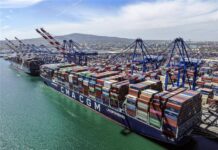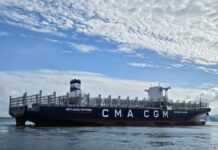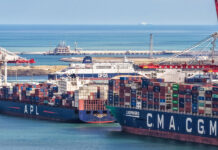
From an investor’s standpoint, shipping used to be what they call a ‘drag’ sector, and shipping company stocks received very less attention when compared to that of technology and finance giants. But the Covid-19 pandemic has significantly changed this situation.
There’s no denying that, for the last 20 years or so, container shipping has struggled in giving back its Return on Invested Capital (ROIC) for shareholders.
With 2021 being the best year in near memory for container shipping, container line profits are estimated to go into the US$190 billion according to Drewry, enough to lure any investor with its return rates.
If Drewy’s predictions do come true, container lines would make two times the profit made by Apple Inc in FY2021. This is a very big deal, especially since Apple is considered the gold standard of profit, being the most profitable company on the face of the earth.
With companies freshly awash with truckloads of cash, it should technically pave the way for smarter investments to hold onto them, instead of just letting them lie around in banks. Let’s discuss some of the options container lines are exploring in a bid to ensure dominance over the industry and the supply chain as a whole:
1. Logistics:
With the advent of e-commerce, one of the things container lines have realized is that the one owning the entirety of the supply chain is the ultimate winner. From picking up your cargo to delivering it to your doorstep on a different continent, companies want to own every step of the process, and that is why container lines have poured in billions into this segment.
Swiss MSC has offered around US$6.4 billion for acquiring a 100% stake in Bolloré Africa Logistics, which would give the company an enormous foothold in the entirety of the African subcontinent, which includes 16 container terminals.
Additionally, Danish Maersk has poured in investments into two warehouse and logistics companies- Visible Supply Chain Management (US) and B2C Europe(Netherlands), in a deal valued near US$1 billion.
Meanwhile, French CMA CGM is all set to acquire the North American, Asia-Pacific, European and Latin American businesses of Ingram Micro’s Commerce and Lifecycle Services in a US$3 billion deal.
2. Startup Investment:
Investment into exciting startups has been a core area that is stressed by market leaders to maximise their profits and ensure more visibility in the entire supply chain processing. Maersk, CMA CGM and MSC, the top three players in the container market have understood the need for incubating exciting startups and recognised the need for broad-scale transparency in the entire supply chain to maintain their competitive edge in the market.
Maersk, via its Maersk Growth venture, has invested in a few startups like HUUB, fast-fashion inventory management and fulfillment software provider, while CMA CGM, via its Zeebox accelerator program, is backing tech companies from all over Europe engaged in the maritime domain.
3. Air Freight:
Pushing more into vertical integration, both Maersk and CMA CGM have actively invested in air freight, a new thing for the container players indeed. In November 2021, CMA CGM ordered four A350 freighters from Airbus, and in September, they ordered two Boeing 777s.
In November again, Maersk formed a joint venture with South Africa’s Grindrod. The Danish giant also acquired Senator International, a German air cargo company, marking aggressive diversification by these behemoths into air freight.
Moreover, MSC recently joined Lufthansa in bidding for Italy’s flagship airline.
4. Acquisitions:
Although no major ocean carrier has been disbanded or declared bankruptcy in the last 1-2 years, a lot of the smaller players have been absorbed by major carriers in 2021. This includes Hapag-Lloyd acquiring NileDutch and MSC acquiring Brazil’s Log-in-Logistica.
5. Newbuilds:
Maersk has ordered around eight container ships fuelled by methanol, which features an interesting design.
However, in the segment of newbuilds, Evergreen is by far the most important player, having a slated orderbook for 46 vessels.
At the same time, HMM has also an order book estimated at US$1.6 billion, which includes twelve 13,000 TEU boxships, while German Hapag-Lloyd has an order book accounting for nearly 20% of its fleet when it comes to active tonnage.
6. Hefty Bonuses:
Outpacing sectors like Finance and Healthcare, the container shipping industry has given out some of the most generous bonuses when it comes to over-performing sectors. Evergreen tops the list again, with reported bonuses of about 40 months salary for some employees.
Caixin Global reported that COSCO employees were paid jaw-dropping year-end bonuses equivalent to 30 times their monthly salary in some cases. Want Hai is following a similar line too, agreeing to pay hefty bonuses to employees.
Last year, Maersk made headlines when it gave away US$1,000 each as bonuses, to its 80,000+ workforce worldwide, and the company said the bonus amount will remain unchanged for 2021.
7. Investment in port terminals:
This form of investment by container lines is the most relied upon, and battle-hardened too.
CMA CGM acquiring a Los Angeles terminal made big headlines in the shipping community worldwide as it was valued at US$2.3 billion.
In addition, Maersk, via its APM Terminal, has acquired a container terminal in the Danish port of Aarhus, while giving away its Rotterdam terminal to Hutchison Ports, while COSCO recently bought a 35% stake in Hamburg’s Container Terminal Tollerort.
In the meantime, there have been other investments by the companies, like share buybacks, repaying debt, chartering ships as well as buying more second-hand tonnage to increase fleet capacity as projections continue to say that the golden period for the industry would continue into 2022.
Ankur Kundu
Correspondent





